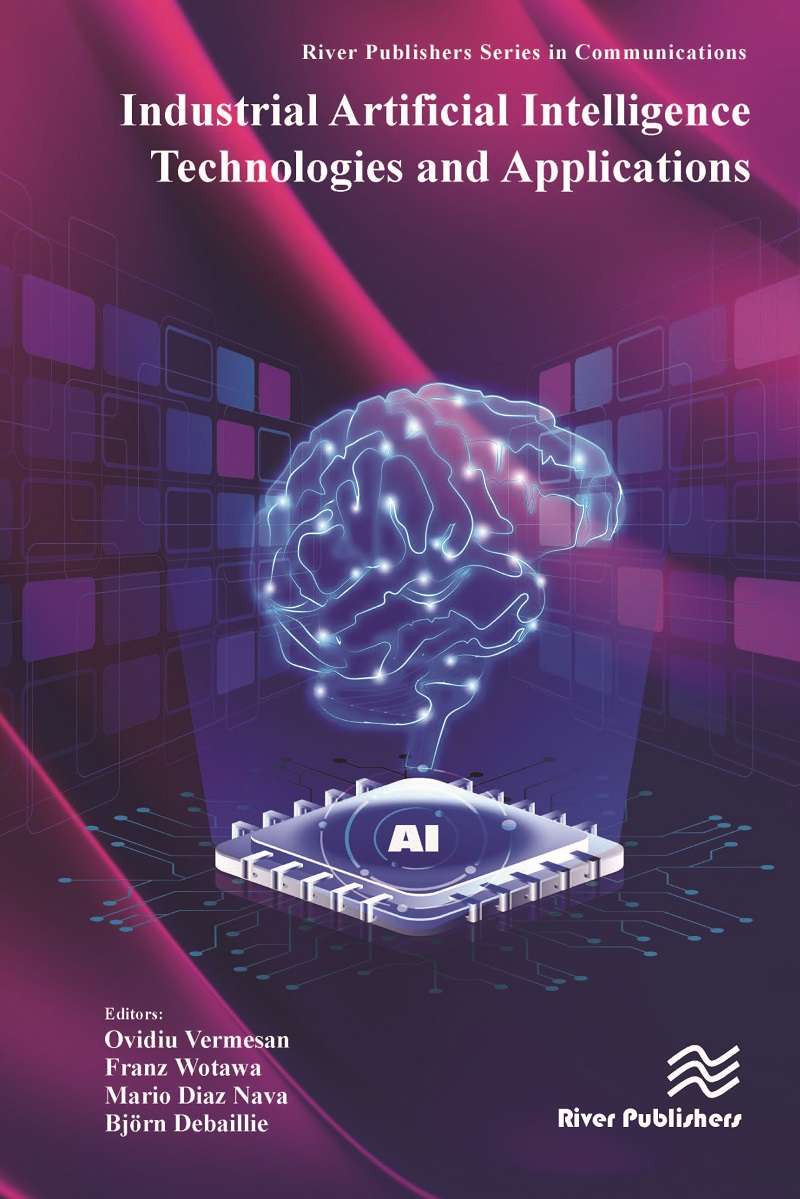Industrial Artificial Intelligence Technologies and Applications
Editors:
Ovidiu Vermesan, SINTEF, Norway
Franz Wotawa, TU Graz, Austria
Mario Diaz Nava, STMicroelectronics, France
Björn Debaillie, imec, Belgium
ISBN: 9788770227919 e-ISBN: 9788770227902
Available: June 2022
Digital transformation is reshaping the manufacturing industry, and industrial edge AI aims to combine the potential advantages of edge computing (low latency times, reduced bandwidth, distributed architecture, improved trustworthiness, etc.) with the benefits of AI (intelligent processing, predictive solutions, classification, reasoning, etc.).
The industrial environments allow the deployment of highly distributed intelligent industrial applications in remote sites that require reliable connectivity over wireless and cellular connections. Intelligent connectivity combines IIoT, wireless/cellular and AI technologies to support new autonomous industrial applications by enabling AI capabilities at the edge and allowing manufacturing companies to improve operational efficiency and reduce risks and costs for industrial applications.
There are several critical issues to consider when bringing AI to industrial IoT applications considering training AI models at the edge, the deployment of the AI-trained inferencing models on the target reliable edge hardware platforms and the benchmarking of the solution compared with other implementations.
The next-generation trustworthy industrial AI systems offer dependability by design, transparency, explainability, verifiability, and standardised industrial solutions to be implemented into various applications across different industrial sectors.
New AI techniques like embedded machine learning (ML) and deep learning (DL) capture edge data, employ AI models and deploy them to hardware target edge devices from ultra-low-power microcontrollers to embedded devices, gateways, and on-premises servers for industrial applications. These techniques reduce latency, increase scalability, reliability, and resilience, and optimise wireless connectivity, greatly expanding IIoT capabilities.
The book overviews the latest research results and activities in industrial artificial intelligence technologies and applications based on the innovative research, developments and ideas generated by the ECSEL JU AI4DI, ANDANTE and TEMPO projects.
The authors describe industrial AI's challenges, the approaches adopted, and the main industrial systems and applications to give the reader a good insight into the technical essence of the field. The articles provide insightful material on industrial AI technologies and applications.
The book is a valuable resource for researchers, post-graduate students, practitioners, and technology developers interested in gaining insight into the industrial edge AI, IIoT, embedded machine and deep learning, new technologies, and solutions to advance the intelligent processing at the edge.
Benchmarking Neuromorphic Computing for Inference
by Simon Narduzzi, Loreto Mateu, Petar Jokic, Erfan Azarkhish, and Andrea Dunbar
Benchmarking the Epiphany Processor as a Reference Neuromorphic Architecture
by Maarten Molendijk, Kanishkan Vadivel, Federico Corradi, Gert-Jan van Schaik, Amirreza Yousefzadeh, and Henk Corporaal
Temporal Delta Layer: Exploiting Temporal Sparsity in Deep Neural Networks for Time-Series Data
by Preetha Vijayan, Amirreza Yousefzadeh, Manolis Sifalakis, and Rene van Leuken
An End-to-End AI-based Automated Process for Semiconductor Device Parameter Extraction
by Dinu Purice, Matthias Ludwig, and Claus Lenz
AI Machine Vision System for Wafer Defect Detection
by Dmitry Morits, Marcelo Rizzo Piton, and Timo Laakko
Failure Detection in Silicon Package
by Saad Al-Baddai and Jan Papadoudis
S2ORC-SemiCause: Annotating and Analysing Causality in the Semiconductor Domain
by Xing Lan Liu, Eileen Salhofer, Anna Safont Andreu, and Roman Kern
Feasibility of Wafer Exchange for European Edge AI Pilot Lines
by Annika Franziska Wandesleben1*, Delphine Truffier-Boutry2*, Varvara Brackmann, Benjamin Lilienthal-Uhlig, Manoj Jaysnkar, Stephan Beckx, Ivan Madarevic, Audde Demarest, Bernd Hintze, Franck Hochschulz, Yannick Le Tiec, Alessio Spessot, and Fabrice Nemouchi
A Framework for Integrating Automated Diagnosis into Simulation
by David Kaufmann and Franz Wotawa
Deploying a Convolutional Neural Network on Edge MCU and Neuromorphic Hardware Platforms
by Simon Narduzzi, Dorvan Favre, Nuria Pazos Escudero and L. Andrea Dunbar
Efficient Edge Deployment Demonstrated on YOLOv5 and Coral Edge TPU
by Ruben Prokscha, Mathias Schneider, and Alfred Höß
Embedded Edge Intelligent Processing for End-To-End Predictive Maintenance in Industrial Applications
by Ovidiu Vermesan and Marcello Coppola
AI-Driven Strategies to Implement a Grapevine Downy Mildew Warning System
by Luiz Angelo Steffenel, Axel Langlet, Lilian Hollard, Lucas Mohimont, Nathalie Gaveau, Marcello Copola, Clément Pierlot, and Marine Rondeau
On the Verification of Diagnosis Models
by Franz Wotawa and Oliver Tazl
